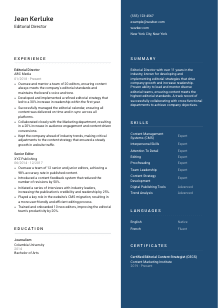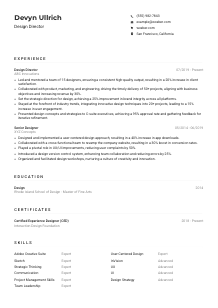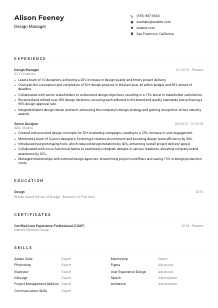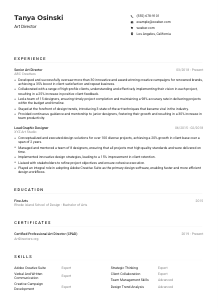Editorial Director Resume Example
Shaping narratives, but your resume reads like fine print? Edit that intro with this Editorial Director resume example, polished with Wozber free resume builder. Learn how to artfully articulate your editorial vision to align with the job narrative, and discover your career at the helm of captivating stories!
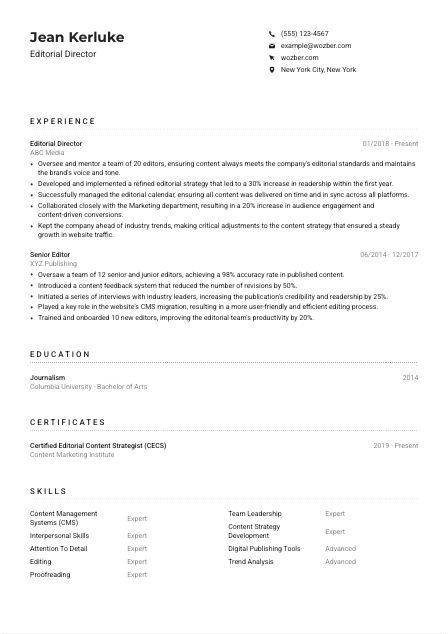
How to write an Editorial Director Resume?
Embarking on a journey to secure the Editorial Director position you've been eyeing? The path to standing out in the highly competitive editorial field begins with crafting a resume that speaks volumes of your expertise, vision, and leadership. Leveraging Wozber's free resume builder, this step-by-step guide will walk you through creating an ATS-compliant resume that perfectly aligns with your dream job. Join us on this narrative-shaping journey, where your resume becomes a compelling story that captivates your next employer.
Personal Details
In the compelling world of editorial leadership, your resume's Personal Details section sets the stage for your professional narrative. This initial handshake with potential employers must be as polished as the copy you'd approve for publication. Let's refine this section to make that impactful first connection.
1. Clearly Define Your Name
Begin with your name as the headline, making it memorable with a clean, professional font. Think of it as the title of your own editorial masterpiece - clear, bold, and leaving a lasting impression.
2. Match the Desired Title
Position yourself as the perfect candidate by mirroring the job title, "Editorial Director," right below your name. It instantly aligns your expertise with the role, making it clear that your career narrative fits perfectly within their script.
3. Essential Contact Details
Include your streamlined contact information - a phone number and a professional email address format, such as firstname.lastname@email.com, are non-negotiable for easy communication. Consider listing your location, "New York City, New York," specifically when the job mandates it, facilitating a smoother recruitment process.
4. Propel Your Professionalism
Adding a LinkedIn profile or a professional website links to your expansive editorial portfolio, inviting hiring managers to dive deeper into your professional world. Ensure these are updated and reflective of your resume to maintain consistency.
5. Trim the Excess
In the edit room of your resume, cut out personal details like age or marital status. Just as you would in crafting a story, keep your audience in mind: the hiring manager, who needs to know why you're the best fit for the Editorial Director role.
Takeaway
Your Personal Details section is the opening paragraph of your compelling career story. Ensure it's crisp, clear, and directly aligned with the Editorial Director role, making the hiring managers eager to turn the page. It's your chance to make a memorable first impression.





Experience
Your experience section is where the plot thickens. It's where you showcase your ability to steer editorial teams towards success, meet deadlines, and enhance readership. Let's meticulously curate your professional journey to highlight your qualifications for the Editorial Director position.
- Oversee and mentor a team of 20 editors, ensuring content always meets the company's editorial standards and maintains the brand's voice and tone.
- Developed and implemented a refined editorial strategy that led to a 30% increase in readership within the first year.
- Successfully managed the editorial calendar, ensuring all content was delivered on time and in sync across all platforms.
- Collaborated closely with the Marketing department, resulting in a 20% increase in audience engagement and content‑driven conversions.
- Kept the company ahead of industry trends, making critical adjustments to the content strategy that ensured a steady growth in website traffic.
- Oversaw a team of 12 senior and junior editors, achieving a 98% accuracy rate in published content.
- Introduced a content feedback system that reduced the number of revisions by 50%.
- Initiated a series of interviews with industry leaders, increasing the publication's credibility and readership by 25%.
- Played a key role in the website's CMS migration, resulting in a more user‑friendly and efficient editing process.
- Trained and onboarded 10 new editors, improving the editorial team's productivity by 20%.
1. Highlight Pertinent Roles
Begin by outlining your editorial career, especially focusing on roles that directly align with the Editorial Director position. Use the job description as your guide to highlight relevant experiences, such as managing editorial teams or developing content strategies.
2. List Them Chronologically
Structure your journey starting with your most recent role, moving backwards. For each position, include your job title, company name, and dates of employment. This timeline will narrate your ascending trajectory in the editorial world.
3. Tailor Your Achievements
Craft achievement statements that resonate with the Editorial Director role. Use action verbs and incorporate metrics to demonstrate your impact. For instance, "Developed and implemented an editorial strategy resulting in a 30% increase in readership within the first year."
4. Quantify Your Editorial Wins
Numbers tell a compelling story. Whenever possible, quantify your accomplishments to provide a tangible sense of your contributions, whether it's increasing readership, boosting engagement, or enhancing team productivity.
5. Relevancy is Key
In editing your career narrative, keep only the most relevant experiences that showcase your qualifications for the Editorial Director role. Less is indeed more when each detail contributes to the story of why you're the ideal candidate.
Takeaway
Your experience section is your opportunity to demonstrate your editorial prowess and leadership capabilities. It's about making every word count, showing not just that you're qualified, but that you're the visionary Editorial Director any company would be lucky to have.
Education
The education section of your resume might seem like a footnote, but in the realm of editorial leadership, it underscores your foundational knowledge. Here's how to ensure this section contributes to the credibility of your narrative as an Editorial Director candidate.
1. Identify Key Educational Requirements
Anchor your education section with the exact degree specified in the job description, such as a "Bachelor's degree in Journalism." This direct match begins to build a picture of you as the ideal Editorial Director candidate.
2. Present with Clarity
For each educational entry, list your degree, field of study, the institution's name, and your graduation date in a clean, easily digestible format. This clarity speaks volumes of your ability to communicate effectively.
3. Degree Alignment
When listing your degree, ensure it's perfectly aligned with the job's requirements. Your "Bachelor of Arts in Journalism" not only checks off a crucial requirement but also highlights your relevant foundational knowledge.
4. Coursework and Specializations
Although not always necessary for senior positions, mentioning relevant coursework or specializations can provide depth to your educational background, especially if they directly relate to the skills and knowledge required for the Editorial Director role.
5. Other Educational Highlights
If there are academic achievements or extracurricular involvements that enhance your candidacy or illustrate skills relevant to editorial leadership, don't hesitate to include them. They add layers to your educational narrative, enriching your profile.
Takeaway
Your education section should lay a solid foundation, showcasing the academic credentials behind your editorial expertise. Let it reflect the depth of your understanding and your readiness to take on the Editorial Director role with aplomb.
Certificates
In the ever-evolving world of content and editorial management, staying updated with the latest trends and acquiring new skills through certifications can set you apart. Let's dive into how to effectively present your certifications for the Editorial Director role.
1. Extract and Align
First, identify certifications that align closely with the job description. Though the job posting for the Editorial Director position may not explicitly require certifications, showcasing relevant ones, such as a "Certified Editorial Content Strategist" certificate, demonstrates your dedication to professional growth.
2. Quality Over Quantity
List certificates that directly reflect the qualifications and expertise required for the Editorial Director role. Highlighting certifications that showcase your strategic content management or leadership skills can offer a competitive edge.
3. Transparency with Dates
Including the dates of your certifications indicates recent and relevant educational endeavors. It reassures employers of your updated knowledge and ongoing commitment to your professional development in the editorial field.
4. A Testament to Dedication
Regularly updating your certifications and pursuing new learning opportunities reflect your eagerness to stay ahead in the editorial game. It shows hiring managers your proactive approach to embracing industry changes and trends.
Takeaway
In the context of your resume, certifications become not just credentials but stories of your dedication to excellence in the editorial field. Let them underscore your commitment to professional growth and your eagerness to lead in a constantly evolving industry.
Skills
The skills section of your resume is like the bibliography of an acclaimed book – concise yet critical to understanding the content's value. For an Editorial Director candidate, this means highlighting both hard and soft skills that demonstrate your editorial acumen and leadership qualities. Let's refine your skills list to ensure it captures the essence of what makes you the ideal candidate for the role.
1. Extract and List Essential Skills
Pour over the job description and identify both hard and soft skills that match your expertise. Skills such as "Content Management Systems (CMS)" expertise, "Interpersonal Skills," and a keen "Attention To Detail" are imperative to include as they directly echo the job's requirements.
2. Prioritize and Organize
Focus on listing skills most relevant to the Editorial Director position. Balance technical proficiencies such as digital publishing with leadership and communication skills, exhibiting your multifaceted capability in the role.
3. Tailor and Streamline
In tailoring your skills section, ensure each listed skill is impactful and relevant. A tightly curated list demonstrates your understanding of the role's core requirements and your ability to meet them head-on.
Takeaway
Your skills section should sing to the tune of your professional narrative, accentuating your editorial expertise and leadership qualities. By carefully selecting and presenting your skills, you illustrate your readiness to lead and innovate in the editorial realm.
Languages
In an increasingly globalized world, the ability to communicate across cultures can be a powerful asset, especially in roles requiring a broad understanding of audience and market nuances. While the job description for the Editorial Director position may not explicitly demand multilingual capabilities, showcasing your language skills can underscore your versatility and global outlook.
1. Assess Job Language Preferences
Initially, review the job description for any language preferences. While the Editorial Director role didn't specify linguistic requirements, being fluent in languages beyond English, like French, can highlight your capacity for wider communication and understanding in a diverse editorial landscape.
2. Prioritize Language Proficiency
List languages in order of proficiency, leading with your strongest. Your native language, followed by additional languages where you're fluent, shows a breadth of communication skills invaluable in shaping content that resonates across different cultures.
3. Showcase Linguistic Versatility
Even if not directly related to the job's requirements, your language skills paint a picture of a well-rounded and adaptable candidate. They signal your ability to lead editorial projects with a global perspective.
4. Honesty in Proficiency Levels
Be clear about your level of proficiency in each language. From "Native" to "Basic," your honesty offers a transparent view of your capabilities, laying the groundwork for trust and reliability in your professional engagements.
5. Global Perspective
Your ability to navigate different languages and cultures is a testament to your potential for leading diverse teams and shaping content that appeals to a global audience. Highlighting your language skills reinforces your fit for an Editorial Director role with a far-reaching impact.
Takeaway
Your language skills are more than just a section on your resume; they're a reflection of your ability to connect and communicate in a multifaceted world. Flaunting your linguistic abilities showcases your readiness to lead in an ever-globalizing editorial landscape.
Summary
A well-crafted summary acts as the preface to your professional narrative, setting the tone for your resume. For an aspiring Editorial Director, this section is your chance to encapsulate your career highlights, skills, and the unique value you bring to the editorial table. Let's construct a summary that leaves hiring managers eager to learn more.
1. Grasp the Core Job Essentials
Start with a deep understanding of the job requirements. Acknowledging what the role entails at its core - from leading editorial teams to strategizing content distribution - will inform how you present your professional summary.
2. Lead with Your Narrative
Open your summary with a bold statement that captures your professional identity. As an "Editorial Director with over 11 years in the industry," you're positioning yourself as a seasoned expert right from the start.
3. Showcase Career Milestones
Highlight key achievements that echo the job description's requirements, such as developing editorial strategies that led to tangible growth. This not only shows you're capable but also that you're a dynamic leader who makes a significant impact.
4. Keep It Succinct
Your summary should be concise yet powerful. In 3-5 lines, distill your career's essence, focusing on your expertise, achievements, and the unique promise of value you bring to the Editorial Director role.
Takeaway
Your summary is the invitation to your professional saga. Craft it with precision and passion, ensuring it reflects both your expertise and your potential to innovate and lead as an Editorial Director. Let it beckon hiring managers to dive deeper into your narrative, eager to discover the stories of success that lie within.
Launching Your Editorial Director Journey
Congratulations on sculpting an ATS-compliant resume that not only meets but exceeds expectations for the Editorial Director position. With each section carefully tailored using Wozber's free resume builder, including ATS-friendly resume templates and an ATS resume scanner for keyword optimization, you're on the path to making your mark in the editorial world. Your resume is now a testament to your expertise, vision, and readiness to lead. The next chapter of your career awaits—apply with confidence and prepare to shape the narratives of tomorrow.

- Bachelor's degree in English, Journalism, Communications, or a related field.
- Minimum of 8 years of experience in editorial roles, preferably with at least 3 years in a leadership position.
- Strong track record of managing editorial teams and delivering high-quality content on deadline.
- Proficiency with content management systems (CMS) and digital publishing tools.
- Exceptional editing, proofreading, and interpersonal skills, with keen attention to detail.
- Candidate must be located in New York City, New York.
- Oversee and mentor the editorial team, ensuring content meets the company's editorial standards and aligns with the brand's voice and tone.
- Develop, implement, and refine the company's editorial strategy with input from key stakeholders.
- Manage the editorial calendar and ensure timely delivery of content across all platforms.
- Collaborate with other departments such as Marketing to ensure content supports broader company objectives.
- Stay informed about industry trends and competitive landscapes, recommending adjustments to the company's content strategies as needed.






